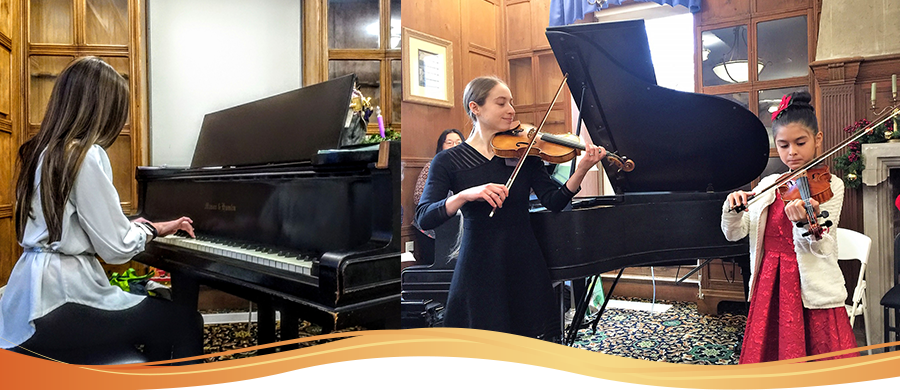
Online
Music for the Community
If you're interested in a particular category, you can sort performances by student age, instrument, singalong music, composer and so on - click on the orange tags under the text. We hope you and your family will enjoy watching our students share their music!
To have each week's videos and accompanying info sent to your inbox*, please subscribe via the orange button.
*Videos are delivered twice weekly; you can unsubscribe at any time, and we will never share or sell your info.
Subscribe to this Page
Displaying items by tag: Suzuki
Day 33: I Want a Popsicle
Day 33: Violinist age 5 plays Twinkle Variation D, “I Want a Popsicle”
Day 28: Etude by Suzuki (Skills, part 3)
Violinist age 8 plays Etude by Suzuki
Day 27: Go, Tell Aunt Rhody (Skills, part 2)
Violinist age 8 plays Go Tell Aunt Rhody
Day 26 - Early Beginners play Twinkle (Skills, part 1)
We're doing something a little different this week - taking you on a journey from the earliest stages of learning an instrument through to musical mastery. First, our beginners who are just learning to pick out a simple tune...
Pianists age 4 play Twinkle, right hand and left hand
Day 24: Down Pony, Up Pony
Violinist age 5 plays Twinkle Variation C, "Down Pony, Up Pony"
Here is another variation on Twinkle, from one of our young Wayland Rec beginners. Again, this bowing pattern will show up later in much more advanced repertoire.
For violin, viola and cello, we call this variation “DOWN pony, UP pony” to emphasize the alternating direction of the strong bow strokes. Others like to call it “Long, short-short, Long, short-short”, while our Suzuki piano teachers often use “Run Mommy, Run Daddy”. Pick one of these, and see if you can keep up singing it all the way through - or maybe chase Mom and Dad around the house!
Day 13: Cuckoo
Pianist age 6 plays "Cuckoo"
This easy piano piece from the Suzuki Piano Program is based on a German folk song, but we gave it English words to help students learn it.
Cuckoo, cuckoo sings from the forest.Cuckoo, cuckoo sings from the tree.
Let us be singing, let us be dancing,Cuckoo, cuckoo, springtime is here!
OR:
Cuckoo, Cuckoo, high in the treetops,Cuckoo, Cuckoo, sing me a song.
Sing in the morning, sing in the evening.Cuckoo, Cuckoo, I’ll sing along!
Day 11: Massachusetts Music (Twinkle Variation A)
Violinist age 4 plays Twinkle Variation A, Massachusetts Music
This is the first piece that the young musicians in our Suzuki Program learn. The rhythm “Massachusetts Music” is an easy one for beginners, as it uses very short bow strokes – but it’s also something that will reappear many times in much bigger pieces, including professional ones.
This little student started in our Wayland Recreation “Small Group Intro to Violin” class over the summer. Five months later, and she was ready to share her music with an audience. She gets extra brownie points for stopping to “build fingers” carefully when she moves to a new string. Skills built solidly in small steps like this will lead to ease and confidence at all levels of playing.
Day 8: Song of the Wind
Violinist age 10 plays Song of the Wind
Here’s another singalong song! (For the last one, see April 9th.)
Who has seen the wind, I wonder?
No-one that I know!
No-one that I know!
When the leaves are / flut-ter-ing the /
Wind is there but/ can’t be seen –
When the leaves are / flut-ter-ing the /
Wind is there I/ know.___(Repeat)
Day 4: O Come, Little Children
Violinist age 7 plays “O Come, Little Children”
This pretty folk song (which is actually a French Christmas carol) is one of the early pieces featured in the Suzuki violin program. This young violinist started out in our Wayland Recreation “Small Group Intro to Violin” class - and that’s his mom playing piano for him!
We give the kids singalong words to help them hear the music in their heads as they learn new songs on their instruments. The words we made up to this one are below, so you can sing along too. The first phrase in each verse repeats because the music does also - listen and sing again, to see if you can hear that happening. You could also make up a third verse with whatever instruments you have at home!
Verse 1
O come, little children, and play all your songs! O come, little children, and play all your songs!
Play violin, viola*, and cello and more – we’ll play round the town, then come back and play more!
[sing: vee-oh-la – stretch it to three syllables]
Verse 2
O come, little children, and play all your songs! O come, little children, and play all your songs!
Play flute, drums and trumpet, and piano, and more - we’ll play round the town, then come back and play more!
Day 1: "Musette" by Bach
Violinist age 9 plays "Musette" by Bach
Johann Sebastian Bach lived from 1685 to 1750. He was born in what is now Germany, was the youngest of 8 children, and had a thorough musical education from his father, uncles and older brother.
He was a very hardworking musician who lived and worked at the courts of various dukes and princes, where he had to produce new music on a weekly basis for courtly events and chapel services. Not surprisingly, his published works number well over 1000, and it's thought that there were many more which have been lost over time.
His main performing instrument was the organ, but he wrote pieces for many other instruments, including voice. He wrote this Musette originally for harpsichord, a forerunner of the modern-day piano. A "Musette" was actually a kind of bagpipe popular at the time, and Bach was trying to imitate one here - if you listen carefully to the piano accompanying the violin, you may be able to hear the held bass note or "pedal tone", just as you would with a bagpipe.


